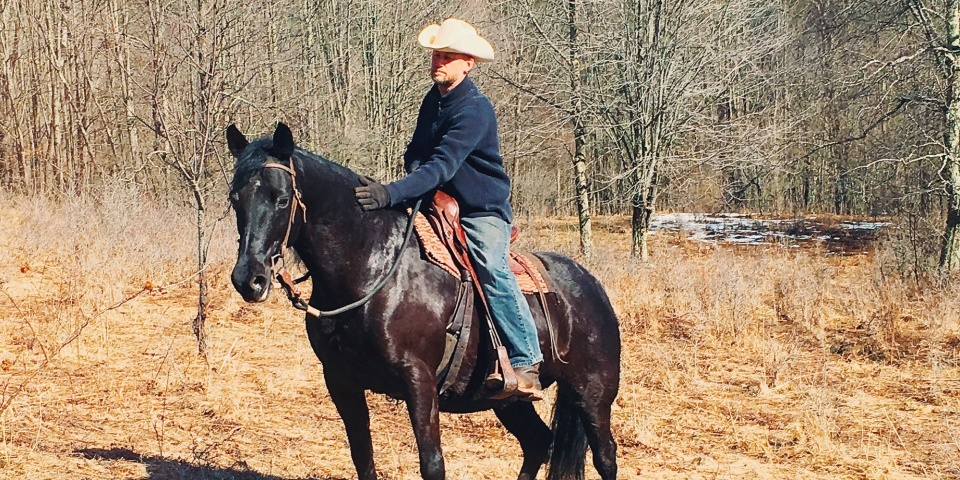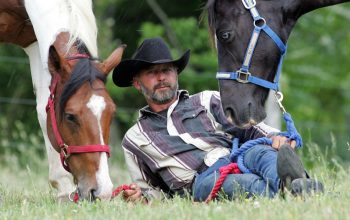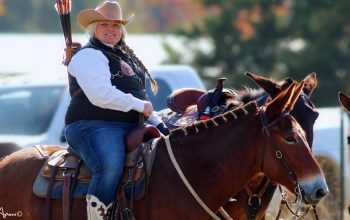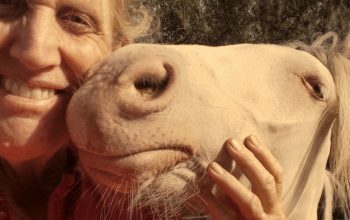By Jeff Wilson
It is hilarious to me in every new encounter, what “song and dance” horses bring with them. I have a couple of new sale horses in the barn that happen to be Morgans. They are my contribution to the world of horse rescuing. In their case, I’m also rescuing them from poor training. My goal in rescuereee-ing isss:
“Here, have a real life with real riders who want a real riding horse.”
You never start crooning that melody anywhere comfortable, however. That’s dreamland. What I have are horses birthed into the world of riding horses with multiple unsoundnesses. Not physical unsoundness like an abscess or crooked legs, but riding defects that prevented them from becoming sound riding horses. Lack of information more than lack of commitment, I believe.
Let me tell you about these characters. One is a 15.3h gelding who was born into a quarter horse world and thusly named with a quarter horse handle, so there’s that. I could easily call him ‘Jughead’ because of his head size, but he’s very people friendly, with a large expressive eye that totally hooks you in. He was started by a Mennonite girl who rode him from farm to farm—what a nice introduction into the working world for him. He probably quickly learned the route and found security in that, while stabling in different barns just stretched his brain right. I picture him as a teenage boy managing his first paper route. No time for thinking about being spooky or silly. As sensitive as he is, that sound training greets you with every interaction you have with him. He always comes back to “settled.” (He’ll stand tied on cross-ties for hours quietly.)
In his next chapter of life he found himself settling into a career as a trail horse for a couple of different riders for a few years, and then I came along. Morgans are like fine wine, they get better with age, and this bright dude has a lot to offer someone. Initially, however, what I have found with him is that along the way his nature—he’s a big dude —took charge. Poor riding habits and “not knowin” gave way to developing a gorilla under the hood that emerges every now and then. I call that half-broke. If you want your arms stretched, he’s the one for you. Is this a horse anybody would want to ride? No.

Another Morgan at my five star retreat is a 14.3h mare who is very sweet and very cute (and has a Morgan name). Her little doe-like face always happily greets you at the door. I was impressed with her ground manners all the way along until I sat in the saddle. Things went horribly upside down wrong from there. Her nose in the air, back-hollowed rhythm sent me into chicken-flapping mode. As a riding horse: Epic Fail. What happened you ask? Lack of information on the essentials of what makes a good sound riding horse.
My next horse, though, took the cake. I think she also ate too much cake. Her withers are so flat you could set up a place setting and have a picnic along her top line with ease. Morgans originated as army mounts and work horses because they are so tough. They can withstand a lot of grind. This 15.3 hand black beauty has withstood a lot of abuse because I think her owner tried to turn her
into a beef cow. “Here, have more cake.” Her initial response to my requests:
“Do I really have to try? You want me to what?…move?”
Fortunately, that mindset is short lived and we are off through the woods, hills, and mountains of the Catskills! She has so much to offer someone, and I love her because she is so completely rock solid on the trail.
So my job, the mountain I must climb with each of these horses, is to untrain the defects people trained in. All the abominable mistakes that left these horses on the island of misfit toys.
First of all, we need to get out of a riding ring. If you care to notice your horse as you ride, you will observe that their body position, or frame, mirrors the physical effort they are involved in. It is important to recognize what the horse is giving you, so you do not hinder their natural movement. As your horse travels through the snow, for instance, he uses his legs more dramatically in movement than he would have if ridden indoors. If any of you ride in the snow you know what I mean. A trot through the snow has so much thrust from behind, and so much lift to it, it brings the experience of passage. Their head and neck also mirror the open frame of the body; the strides are open and forward through all the gaits. The neck is no longer tight and upright like it wants to be at the beginning of the ride, but now the neck’s underside is flexed and forward with a nice open throat. And to that, on Dasher.
Why is this important? Think about range of motion, the opening and closing of our muscles and joints. Anyone over fifty knows how valuable that can be. One of our goals of riding is suppleness. A supple horse can freely open and close all its muscles and joints of the body for the largest possible range of motion. Something none of these three horses can do.
My new horses need a GIANT fix. To get a horse to become more flexible means they can perform with ease the movements we enjoy doing with them. A flexible horse enjoys what it can do, and we can enjoy the ride. To get a horse to become supple primarily involves turning on circles, teaching the horse to bend, and moving laterally. Simply speaking, teaching turn on the forehand and leg yield will markedly reveal their suppling effects as they are mirrored through the body; the horse’s frame begins to respond to the increased flexion. But at the start, I prefer to let the natural terrain do that job for me.
Here’s the bottom line:
If you don’t have a suppled horse as a riding goal first, you’ll get unnatural body positions, compression, and tension as a result defects.
So what’s the fix? The greater the range of motion, the greater the degree you will be able to achieve suppleness, then collection and impulsion. A supple horse moves with a forward, open, and arched neck. Its hind legs are open, reaching (flexing) forward, which will reflect in a topline that becomes stretched and lifted as well. Great movement, balance, straightness, collection—all are a result of a chain of events through the horse’s body. Any blockages must be suppled. Congratulations if you achieved this shape in your riding!
 I’m over yonder at the edge of nothing, laying in the dirt with the social media stampede. Please take some time and “like” us on FACEBOOK so I can stand back up, dust myself off, and smile like that goat in yer rose garden. I have been training horses for over 35 years and value the western horse lifestyle in my approach to training. Giving clinics and seminars on how to reach your full potential with your horse through the training foundation of Cowboy Dressage keeps me young.
I’m over yonder at the edge of nothing, laying in the dirt with the social media stampede. Please take some time and “like” us on FACEBOOK so I can stand back up, dust myself off, and smile like that goat in yer rose garden. I have been training horses for over 35 years and value the western horse lifestyle in my approach to training. Giving clinics and seminars on how to reach your full potential with your horse through the training foundation of Cowboy Dressage keeps me young.




